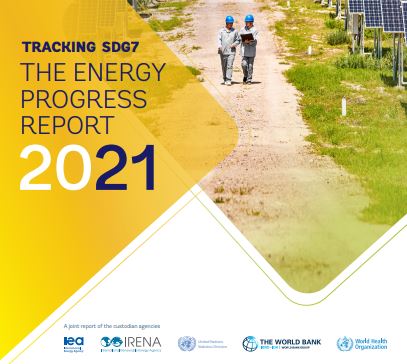
Tracking SDG7: The Energy Progress Report says that during the past decade, a greater share of the global population gained access to electricity than ever before, but the number of people without electricity in Sub-Saharan Africa increased. Unless efforts are scaled up significantly in countries with the largest deficits, the world will still fall short of ensuring universal access to affordable, reliable, sustainable and modern energy by 2030.
The report was released by the International Energy Agency (IEA), International Renewable Energy Agency (IRENA), UN Department of Economic and Social Affairs (UN DESA), World Bank, and World Health Organization (WHO).
According to the report, significant progress has been made since 2010 on various aspects of the Sustainable Development Goal (SDG) 7, but progress has been unequal across regions. More than 1 billion people gained access to electricity globally over the past decade, but COVID’s financial impact has made basic electricity services unaffordable for 30 million more people, the majority located in Africa. Nigeria, the Democratic Republic of Congo, and Ethiopia had the biggest electricity access deficits, with Ethiopia replacing India in the Top 3.
Globally, the number of people without access to electricity declined from 1.2 billion in 2010 to 759 million in 2019. Electrification through decentralized renewable-based solutions in particular gained momentum. The number of people connected to mini grids more than doubled between 2010 and 2019, growing from 5 million to 11 million. However, an estimated 660 million people would still lack access in 2030, most of them in Sub-Saharan Africa.
The report examines ways to bridge the gaps to reach SDG7, chief among them the goal of significantly scaling up renewables. While renewable energy has seen unprecedented growth over the past decade, its share of total final energy consumption remained steady as global energy consumption grew at a similar rate. Renewables are most dynamic in the electricity sector, reaching around 25% in 2018, while progress in the heat and transport sectors has been much slower.
More than one third of the increase in renewable energy generation in 2018 can be attributed to East Asia, driven by large uptakes of solar and wind energy in China. The largest country-level advances in renewable energy in 2018 were in Spain, owing to higher hydropower generation, followed by Indonesia, with a rapid uptake of bioenergy.
Accelerating the pace of progress across all regions and indicators will require stronger political commitment, long-term energy planning, and adequate policy and scale incentives to spur faster uptake of sustainable energy solutions. Although clean energy investments continue to be sourced primarily from the private sector, the public sector remains a major source of financing and is central in leveraging private capital, particularly in developing countries and in a post-COVID context. One of the newest indicators in the report, international public financial flows to developing countries, shows that international financial support continues to be concentrated in a few countries and failing to reach many of those most in need. Flows to developing countries in support of clean and renewable energy reached $14 billion in 2018, with a mere 20% going to the least-developed countries. An increased emphasis on “leaving no one behind” is required in the years ahead.
The COVID-19 crisis resulted in an estimated 7% year-on-year expansion of renewable electricity generation, supported by long-term contracts, low marginal costs, priority access to grids and installation of new renewable capacity. In contrast, renewable energy share for transport and heat declined in 2020. Renewable electricity accounts for almost half of global renewable energy consumption and three-quarters of its year-on-year increase, with hydropower being the largest renewable source of electricity globally and for each region. Heat had only a 1.2% absolute increase when it came to renewable sources. Coal, gas and oil still meet three-quarters of global heat demand. Transport has the lowest renewable energy penetration of all sectors, with only 3.4% in 2018 being supplied by renewables. While Sub-Saharan Africa has the largest share of renewable sources in its energy supply, it is not modern – 85% is traditional uses of biomass. Latin America and the Caribbean have the largest share of modern renewable energy uses, thanks to hydropower for electricity, bioenergy for industrial processes and biofuels for transport.
“On a global path to achieving net-zero emissions by 2050, we can reach key sustainable energy targets by 2030 as we expand renewables in all sectors and increase energy efficiency,” said Fatih Birol, executive director of IEA. “Greater efforts to mobilize and scale up investment are essential to ensure that energy access progress continues in developing economies. Providing electricity access and clean cooking solutions to those people who are deprived of them today costs around $40 billion a year, equal to around 1% of average annual energy sector investment on a path to net zero by 2050. This fairer and cleaner energy future is achievable if governments work together to step up actions.”
“Renewable energy has proven itself to be reliable, cost-effective, and resilient during the pandemic, revealing its significant value at the forefront of the energy transition. But progress towards the achievement of climate objectives and SDG7 needs to move at an accelerated pace and equitable manner,” said Francesco La Camera, director-general of IRENA. “Efforts, including international public financial flows to renewables, must be scaled up to support countries that need the most improvement in clean, affordable, and sustainable energy access, healthcare, and welfare.”
This is the seventh edition of this report, formerly known as the Global Tracking Framework (GTF). This year’s edition was chaired by the United Nations Statistics Division. Funding for the report was provided by the World Bank’s Energy Sector Management.





